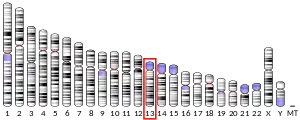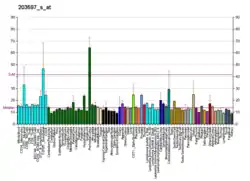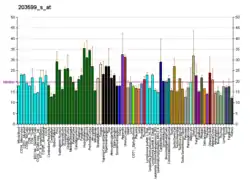| WBP4 | |||||||||||||||||||||||||||||||||||||||||||||||||||
|---|---|---|---|---|---|---|---|---|---|---|---|---|---|---|---|---|---|---|---|---|---|---|---|---|---|---|---|---|---|---|---|---|---|---|---|---|---|---|---|---|---|---|---|---|---|---|---|---|---|---|---|
 | |||||||||||||||||||||||||||||||||||||||||||||||||||
| |||||||||||||||||||||||||||||||||||||||||||||||||||
| Identifiers | |||||||||||||||||||||||||||||||||||||||||||||||||||
| Aliases | WBP4, FBP21, WW domain binding protein 4 | ||||||||||||||||||||||||||||||||||||||||||||||||||
| External IDs | OMIM: 604981 MGI: 109568 HomoloGene: 38287 GeneCards: WBP4 | ||||||||||||||||||||||||||||||||||||||||||||||||||
| |||||||||||||||||||||||||||||||||||||||||||||||||||
| |||||||||||||||||||||||||||||||||||||||||||||||||||
| |||||||||||||||||||||||||||||||||||||||||||||||||||
| |||||||||||||||||||||||||||||||||||||||||||||||||||
| |||||||||||||||||||||||||||||||||||||||||||||||||||
| Wikidata | |||||||||||||||||||||||||||||||||||||||||||||||||||
| |||||||||||||||||||||||||||||||||||||||||||||||||||
WW domain-binding protein 4 is a protein that in humans is encoded by the WBP4 gene.[5][6]
This gene encodes WW domain-containing binding protein 4. The WW domain represents a small and compact globular structure that interacts with proline-rich ligands. This encoded protein is a general spliceosomal protein that may play a role in cross-intron bridging of U1 and U2 snRNPs in the spliceosomal complex A.[6]
References
- 1 2 3 GRCh38: Ensembl release 89: ENSG00000120688 - Ensembl, May 2017
- 1 2 3 GRCm38: Ensembl release 89: ENSMUSG00000022023 - Ensembl, May 2017
- ↑ "Human PubMed Reference:". National Center for Biotechnology Information, U.S. National Library of Medicine.
- ↑ "Mouse PubMed Reference:". National Center for Biotechnology Information, U.S. National Library of Medicine.
- ↑ Bedford MT, Reed R, Leder P (Sep 1998). "WW domain-mediated interactions reveal a spliceosome-associated protein that binds a third class of proline-rich motif: the proline glycine and methionine-rich motif". Proc Natl Acad Sci U S A. 95 (18): 10602–7. Bibcode:1998PNAS...9510602B. doi:10.1073/pnas.95.18.10602. PMC 27941. PMID 9724750.
- 1 2 "Entrez Gene: WBP4 WW domain binding protein 4 (formin binding protein 21)".
Further reading
- Takahara T, Tasic B, Maniatis T, et al. (2005). "Delay in synthesis of the 3' splice site promotes trans-splicing of the preceding 5' splice site". Mol. Cell. 18 (2): 245–51. doi:10.1016/j.molcel.2005.03.018. PMID 15837427.
- Gerhard DS, Wagner L, Feingold EA, et al. (2004). "The status, quality, and expansion of the NIH full-length cDNA project: the Mammalian Gene Collection (MGC)". Genome Res. 14 (10B): 2121–7. doi:10.1101/gr.2596504. PMC 528928. PMID 15489334.
- Dunham A, Matthews LH, Burton J, et al. (2004). "The DNA sequence and analysis of human chromosome 13". Nature. 428 (6982): 522–8. Bibcode:2004Natur.428..522D. doi:10.1038/nature02379. PMC 2665288. PMID 15057823.
- Ota T, Suzuki Y, Nishikawa T, et al. (2004). "Complete sequencing and characterization of 21,243 full-length human cDNAs". Nat. Genet. 36 (1): 40–5. doi:10.1038/ng1285. PMID 14702039.
- Strausberg RL, Feingold EA, Grouse LH, et al. (2003). "Generation and initial analysis of more than 15,000 full-length human and mouse cDNA sequences". Proc. Natl. Acad. Sci. U.S.A. 99 (26): 16899–903. Bibcode:2002PNAS...9916899M. doi:10.1073/pnas.242603899. PMC 139241. PMID 12477932.
- Bedford MT, Frankel A, Yaffe MB, et al. (2000). "Arginine methylation inhibits the binding of proline-rich ligands to Src homology 3, but not WW, domains". J. Biol. Chem. 275 (21): 16030–6. doi:10.1074/jbc.M909368199. PMID 10748127.
- Chan DC, Bedford MT, Leder P (1996). "Formin binding proteins bear WWP/WW domains that bind proline-rich peptides and functionally resemble SH3 domains". EMBO J. 15 (5): 1045–54. doi:10.1002/j.1460-2075.1996.tb00442.x. PMC 450002. PMID 8605874.
This article is issued from Wikipedia. The text is licensed under Creative Commons - Attribution - Sharealike. Additional terms may apply for the media files.







